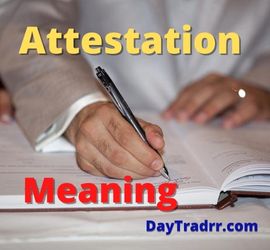Attestation Meaning – What Is Attestation?
 Attestation Meaning: Witnessing the signing of a legal document and verifying with your signature that the individuals correctly signed it. It is the act of witnessing someone sign a legal document, such as a will or power of attorney, and then signing your own name. When a document is witnessed in this manner it is called attesting. That is, testifying and verifying that the person you witnessed signing the paper actually did so in your presence. Attesting to a document does not imply that you are endorsing its correctness or veracity. You are simply stating that you witnessed it being signed by the individual whose name appears on the signature line.
Attestation Meaning: Witnessing the signing of a legal document and verifying with your signature that the individuals correctly signed it. It is the act of witnessing someone sign a legal document, such as a will or power of attorney, and then signing your own name. When a document is witnessed in this manner it is called attesting. That is, testifying and verifying that the person you witnessed signing the paper actually did so in your presence. Attesting to a document does not imply that you are endorsing its correctness or veracity. You are simply stating that you witnessed it being signed by the individual whose name appears on the signature line.
In other words, attestation is the act of witnessing the endorsement of a formal document. Then, also signing it to verify that it was properly signed by those bound by its contents. It is a legal acknowledgment of the authenticity of a document and a verification that proper processes were followed. The person verifying the authenticity or validity of something or someone is called the attester. These assertions of truth are usually confirmed in writing to certify the statements.
Attestation Meaning – A Closer Look
In general, an attestation is a third-party acknowledgment of the legitimacy of a written agreement. The person or entity acting as the witness should ideally have no professional or personal ties to either signatory. This condition is enforced by state probate law in several states. Attestations are most usually linked with agreements of significant personal and financial importance. For example, wills or powers of attorney. When a witness files a police report, he or she must provide an attestation. The witness signs to indicate that their story is correct. The testator then signs to certify that the first signature was genuine. False certifications may violate the False Claims Act of the United States, and violators may face damages and additional penalties. Notarization, on the other hand, requires a state-commissioned notary public to not only sign but also stamp the document in question.
Many of the Fraud Section’s cases are suits filed under the False Claims Act (FCA), 31 U.S.C. §§ 3729 – 3733. It is a federal statute originally enacted in 1863. The Act was a response to defense contractor fraud during the American Civil War. The FCA provided that any person who knowingly submitted false claims to the government was liable for double the government’s damages plus a penalty of $2,000 for each false claim. The FCA has been amended several times. It now provides that violators are liable for treble damages plus a penalty linked to inflation. Under the Act, The United States can pursue perpetrators of fraud on its own. However, private citizens can file suits on behalf of the government (called “qui tam” suits) against those who have defrauded the government. Private citizens who successfully bring qui tam actions may receive a portion of the government’s recovery. (Source: justice.gov)
Attestation Meaning – How it Works
Wills and trusts frequently include attestations. In this case, an attestator often verifies:
- Soundness of mind – That the testator signing the will is of sound mind.
- Voluntary signatory – That the testator voluntarily executed the will or document as a statement of their intentions.
- Physical witness – That the will was signed by the testator and witnessed by the person performing the attestation.
In the United States, state probate law governs the form and application of attestation provisions to legal instruments. Attestation clauses differ slightly from state to state. However, the attestator’s core function and intent are often consistent. The American Bar Association released a Model Probate Code in 1946. It was meant to serve as a legal standard. Most state probate codes are based on the 1946 code, with slight changes here and there. The most notable differences in attestation clauses from state to state concern who can undertake third-party attestation.
What Is the Attestation Clause?
The attestation clause is the witness’ declaration at the end of a document. It certifies that the document was legitimately performed. The will is presumed to be in accordance with all legal requirements once the witness signs it. Attestation provisions are frequently used with legal instruments that only take effect after witnessing, such as wills or deeds. A typical attestation clause begins, “Sealed and given in our presence.” The attesting witness is someone appointed by the legal parties of a document to sign it. Their duty is to verify that they witnessed it and for certification purposes.
Attestation Meaning Versus Notarization
There are many differences between a notarization and an attestation. Only a state-sanctioned official can perform a notarization. Attestations and Notarizations are not the same things. It’s critical to understand the distinction when you need a crucial document signed.
Attestation – When a person who is not involved in the transaction (a third party) “attests” or witnesses the two participating parties signing a document, this is referred to as an attestation. The third party then signs a statement that he or she witnessed the two parties involved signing the document. Sometimes the attestor is required to confirm the substance itself. Witness attestations are not uncommon for legal documents, especially for high-value transactions.
Notarization – Notarization is the process of assuring all parties involved in a transaction that the document they are signing is genuine. It is an attempt to avoid fraud and ensure that each signer is genuine. A notary is only responsible for confirming the signatures on a document, not its contents. Notarization is sometimes required for the principal signer and trustworthy witnesses. Although a notary public can deliver an attestation, he or she cannot notarize his or her own signature. This must be done by another notary.
Attestation Examples
Attestation provisions are most commonly seen in wills and trusts, as well as other legal agreements. They can, however, be found in other industries and disciplines such as medicine and healthcare. Medicare services, physicians, and medical directors frequently sign attestations. Particularly, when working with medical students and residents, as well as when providing or ordering.
Medicare services provided/ordered must be authenticated by the author by some form of signature. This includes orders and medical record documentation of all services provided. The signature must include the credentials of the individual and be dated. The method used shall be a handwritten (may be faxed), or an electronic signature. Stamped signatures are generally not acceptable. CMS permits the use of a rubber stamp for signature in accordance with the Rehabilitation Act of 1973 in the case of an author with a physical disability that can provide proof to a CMS contractor of his/her inability to sign their signature due to their disability. By affixing the rubber stamp, the provider is certifying that they have reviewed the document. The attestation statement must be signed and dated by the author of the medical record entry and must contain sufficient information to identify the beneficiary. (Source: cgsmedicare.com)
Attestation example for a permanent resident application
Consider a foreign spouse of an American citizen who files for permanent residence in the United States. That individual must produce testimonies from witnesses who witnessed the couple together during their stay in the United States. Green card applicants frequently request neighbors, friends, or clergy to submit a letter attesting they witnessed the individuals interacting as a couple. An attestation would be the witness’ signature on that document.
The Bottom Line
Attestation is the process of validating the authenticity of a document and the signatures on it. The party attesting to the truthfulness of the document’s agreement should be an uninterested third party. This is to avoid a conflict of interest. Attestations in legal documents, such as wills and trusts, are often governed by state probate rules. Attestations are not limited to legal papers and can be utilized in any profession or discipline.
Up Next: She/Her Meaning – What Does “She-Her-Hers” Mean in a Bio?
 She/her meaning: In a signature or bio “she-her-hers” means that the person identifies as female and those are the gender pronouns she prefers. Maybe you have come across “she-her-hers” or “he-him-his” in an email signature or in communication. Or, you may have noticed it used in a person’s biographical data on social media. Were you confused? What does she/her mean in a signature?
She/her meaning: In a signature or bio “she-her-hers” means that the person identifies as female and those are the gender pronouns she prefers. Maybe you have come across “she-her-hers” or “he-him-his” in an email signature or in communication. Or, you may have noticed it used in a person’s biographical data on social media. Were you confused? What does she/her mean in a signature?
Simply put, she-her-hers in a signature means that the person wishes to identify herself as a female. People add these personal gender pronouns to an email signature or communication. When he or she does, that person is telling you that he or she identifies with that particular gender.




